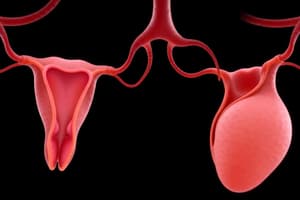Podcast
Questions and Answers
What is the main difference between asexual and sexual reproduction?
What is the main difference between asexual and sexual reproduction?
- Asexual reproduction requires meiosis to produce sex cells.
- Asexual reproduction involves the fusion of male and female gametes.
- Sexual reproduction leads to genetic variation among progeny. (correct)
- Sexual reproduction results in offspring genetically identical to the parent organism.
What is the specific process in sexual reproduction that involves the production of sperms and eggs?
What is the specific process in sexual reproduction that involves the production of sperms and eggs?
- Gametogenesis
- Fertilization
- Mitosis
- Meiosis (correct)
Which of the following organs is part of the male reproductive system?
Which of the following organs is part of the male reproductive system?
- Testes (correct)
- Ovaries
- Uterus
- Fallopian tubes
Where do fertilization and meiosis take place in sexual reproduction?
Where do fertilization and meiosis take place in sexual reproduction?
What is the function of the scrotum in the male reproductive system?
What is the function of the scrotum in the male reproductive system?
How many chromosomes does a diploid zygote contain?
How many chromosomes does a diploid zygote contain?
Where does sperm production primarily take place?
Where does sperm production primarily take place?
What is the function of the epididymis in the male reproductive system?
What is the function of the epididymis in the male reproductive system?
During ovulation, where does the ripened egg cell move towards?
During ovulation, where does the ripened egg cell move towards?
What is the site of fertilization in the female reproductive system?
What is the site of fertilization in the female reproductive system?
Which stage of pregnancy begins after fertilization?
Which stage of pregnancy begins after fertilization?
What has understanding reproductive systems led to advancements in?
What has understanding reproductive systems led to advancements in?
Flashcards are hidden until you start studying
Study Notes
Reproduction is a vital process through which species continue their life cycles by producing new individuals. It involves two main types of processes: asexual reproduction and sexual reproduction. Asexual reproduction occurs without fertilization and results in offspring genetically identical to the parent organism, while sexual reproduction requires the fusion of male and female gametes from different parents, leading to genetic variation among progeny. In this article, we will focus specifically on sexual reproduction and its components, including the reproductive system.
Sexual Reproduction
Sexual reproduction begins with meiosis, where sperms (spermatozoa) and eggs (oocytes) are produced. These sex cells contain half the number of chromosomes present in normal body cells. During fertilization, if one sperm fuses with an egg, both sets of chromosomes come together again, resulting in a diploid zygote containing all 46 human chromosomes. This restores the original number of chromosomes, ensuring each cell carries the complete set required for development.
In humans, the reproductive organs involved in sexual reproduction are located within the pelvic cavity and consist of external structures called the testes for males and ovaries for females. Additionally, there are internal structures such as the uterus, fallopian tubes, vagina, penis, and scrotum.
The male reproductive system produces millions of sperm cells daily during puberty until death. Sperm production takes place primarily in the seminiferous tubules found in the testes. The mature sperm cells move into the epididymis, a coiled tube behind the testes where they are stored and further developed before being expelled into the urethra during ejaculation.
The female reproductive system also undergoes maturation during puberty. Each month, hormonal changes cause the wall of the ovary to rupture, releasing a ripened egg cell (ovulation), which moves down the fallopian tube towards the uterus. If it encounters sperm along the way, fertilization can occur, and the resultant zygote implants itself into the lining of the uterus to grow.
For successful pregnancy, several stages must happen:
- Male and Female Gamete Production: Requires functional gonads (testes for males, ovaries for females).
- Gamete Maturation: Occurs in either the seminal vesicle (males) or the uterine tube (females).
- Fertilization: Occurs when sperm penetrates the egg's cell membrane.
- Embryonic Development: Begins after fertilization.
Reproductive systems are essential for maintaining populations and preserving genetic variety across generations. Understanding these complex mechanisms has led to significant advancements in medical treatments, family planning methods, and contraception options, making it easier for people to plan and manage their families.
Studying That Suits You
Use AI to generate personalized quizzes and flashcards to suit your learning preferences.




